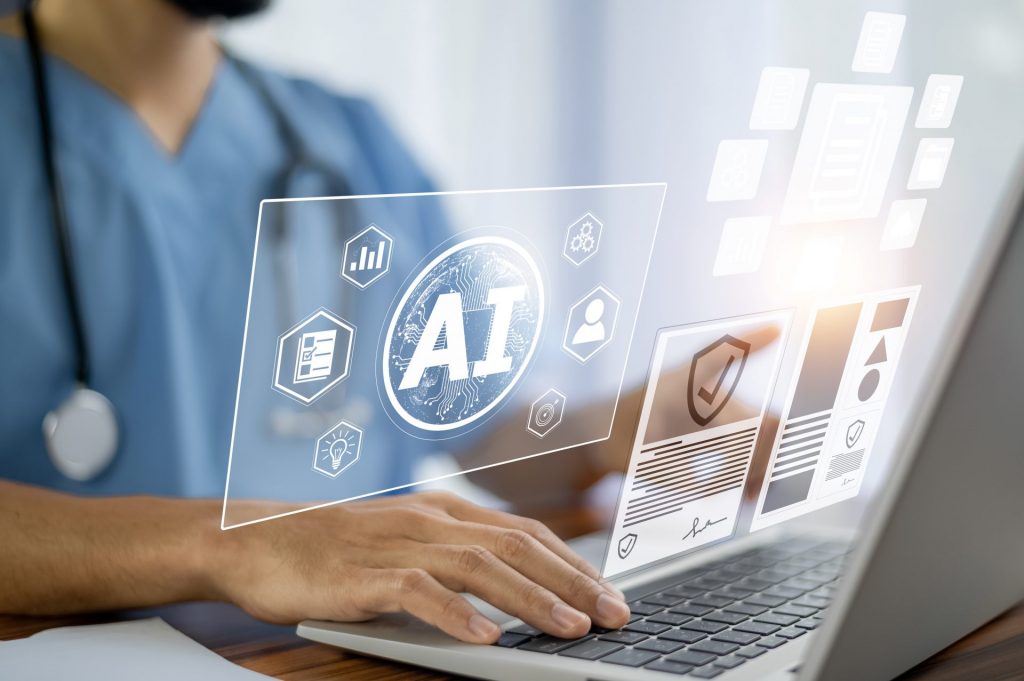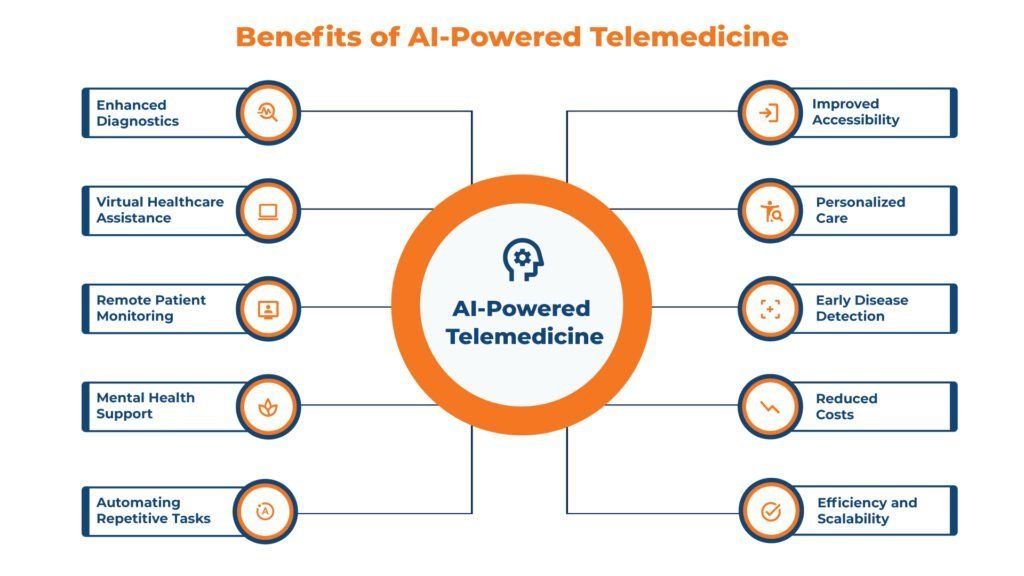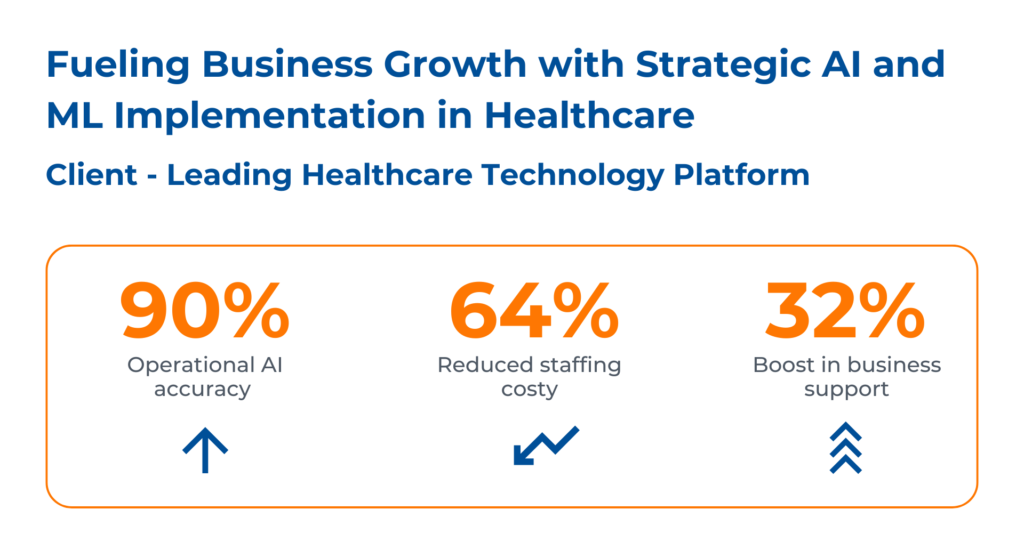Remember that scene in Star Trek: Voyager where the Doctor uses a holographic communicator to diagnose a patient on a distant planet? Well, forget warp drive – AI in telemedicine is bringing that kind of futuristic healthcare to reality today.
According to a report by Grand View Research, the global market for telemedicine was valued at $101.2 billion in 2023 and is expected to grow at a CAGR of 24.3% from 2024 to 2030. The report also stated that the integration of AI in telemedicine is one of the key factors driving this growth.
The integration of artificial intelligence (AI) in telemedicine has been one of the most significant developments in recent years as it leads to better patient outcomes, easier and quicker access to healthcare services, and lower healthcare expenditures.
What is Telemedicine?
Telemedicine is a novel approach to healthcare services that increases accessibility to medical services and improves the quality of medical care provided to patients, especially those living in remote places.
Telemedicine is not just about having virtual consultations with doctors, nurses, or other healthcare professionals. It is a practice that includes a variety of remotely administered healthcare services, such as:
- Tele-interactions
- Tele-assessments
- Tele-diagnosis
- Remote patient monitoring

Telemedicine is extremely beneficial to:
- Patients with chronic diseases and require frequent monitoring
- Those residing in remote areas without proper medical facilities
- Individuals facing difficulty in commuting from one place to another
Besides improving convenience and accessibility to quality healthcare services, telemedicine also decreases the burden on medical facilities. Another big advantage of telemedicine is the allocation of resources, from non-urgent cases towards more critical patients. Through remote consultation of not-so-critical patients, telemedicine allows medical facilities to attend to the needs of those who require emergency care.
The addition of Artificial Intelligence (AI) to telemedicine can expand and improve its capabilities, giving endless possibilities for development of solutions to specific needs.

How AI is Making a Difference in Telemedicine
“Machine Intelligence is the last invention that humanity will ever need to make” – Nick Brostrom, Philosopher at University of Oxford.
Telemedicine is a rapidly growing field that is changing the way healthcare services are delivered. It allows patients to get healthcare consultation without having to physically visit a healthcare clinic. They can choose the doctor and the healthcare service provider of their choice and book a consultation at a time that is convenient to them. By integrating artificial intelligence (AI) with telemedicine, the services can be more streamlined and efficient.
Today, most healthcare service providers have been increasingly utilizing AI-powered telemedicine tools to improve patient outcomes and reduce the burden on healthcare professionals.
As per the report by National Bureau of Economic Research, implementing AI in healthcare can reduce the expenses from 5-10% (approximately $200 billion and $360 billion per year) in the USA.
The Role of AI is Enhancing Remote Patient Care
“AI has allowed me, as a physician, to be 100% present for my patients,” says Michelle Thompson, Family Medicine Specialist, University of Pittsburgh Medical Center.
She utilizes a smartphone-based generative AI tool that seamlessly records, summarizes, and organizes interactions with patients, allowing her to focus completely on their care and well-being.
Advancements in technology, particularly artificial intelligence (AI), are revolutionizing healthcare services provided through the transformative practice of telemedicine. Remote care is becoming not only more accessible but also more effective.
Problems associated with storing, processing, and managing big and complex datasets, along with the need for faster, more accurate diagnoses are chief factors propelling AI’s utilization in telemedicine.

AI-Driven Telemedicine: Innovating Healthcare Delivery
By implementing AI technologies, you can get more accurate and efficient treatments, diagnostics, and results. Not only that, AI-powered telemedicine software can analyze vast amounts of patient data easily which eliminates the need for an extensive workforce who are dedicated to data analysis or scrutiny.
For instance, some advanced AI algorithms use patient data to identify individuals who are at high risk of developing chronic conditions such as diabetes or heart disease. By identifying the disease at an early stage, healthcare providers can take appropriate action to stop the worsening of the disease.
AI-enabled telemedicine services can automatically interpret patient data and assist physicians in responding and adapting quickly to new technologies. This gives them a chance to treat more patients using telemedicine technologies.

Key Applications of AI in Telemedicine

1. Remote Patient Monitoring
Remote patient monitoring leverages AI to continuously track patients’ health status outside traditional healthcare settings. This application has revolutionized chronic disease management and post-operative care, allowing for early intervention and reducing hospital readmissions.
- AI-powered wearable devices and IoT sensors
- Real-time data analysis and anomaly detection
- Personalized alerts for patients and healthcare providers
- Predictive analytics for potential health issues
2. Virtual Health Assistants
AI-driven virtual health assistants serve as the first point of contact for many patients, providing 24/7 support and guidance. These systems use natural language processing and machine learning to understand patient queries and provide appropriate responses.
- Chatbots for initial symptom assessment and triage
- AI-powered symptom checkers for preliminary diagnosis
- Appointment scheduling and medication reminders
- Mental health support and counseling
3. Diagnostic Support
AI significantly enhances diagnostic capabilities in telemedicine by analyzing complex medical data and imaging. This application improves accuracy, speed, and consistency in diagnoses, particularly in specialties like radiology and dermatology.
- AI-powered analysis of medical images (X-rays, CT scans, MRIs)
- Automated detection of anomalies in medical imaging
- Natural Language Processing for analyzing electronic health records
- Integration of multiple data sources for comprehensive diagnoses

4. Treatment Planning
AI assists healthcare providers in developing personalized treatment plans by analyzing patient data, medical history, and the latest research. This application ensures that treatments are tailored to individual patient needs and based on the most current medical knowledge.
- AI-assisted medication management and drug interaction checks
- Personalized treatment recommendations based on patient data
- Prediction of treatment outcomes and potential side effects
- Continuous learning from treatment efficacy data
5. Predictive Analytics
Predictive analytics in telemedicine uses AI to forecast potential health issues before they become severe. This proactive approach enables early intervention and helps in managing population health more effectively.
- Early detection of diseases based on subtle changes in patient data
- Risk stratification for patient populations
- Prediction of hospital readmission risks
- Forecasting of disease outbreaks and healthcare resource needs
6. Telesurgery and Robotic Assistance
AI is pushing the boundaries of telemedicine by enabling remote surgeries and providing robotic assistance. This application allows expert surgeons to operate on patients from a distance, potentially saving lives in areas with limited access to specialized surgical care.
- AI-enhanced surgical robots for precise movements
- Real-time data analysis during surgical procedures
- Augmented reality overlays for surgical guidance
- Predictive models for surgical outcomes and complications
7. Medical Training and Education
AI in telemedicine also plays a crucial role in training healthcare professionals. It provides realistic simulations and personalized learning experiences, enhancing the skills of medical practitioners in remote diagnosis and treatment.
- AI-powered virtual patients for training scenarios
- Personalized learning paths based on individual performance
- Simulation of rare medical conditions and emergencies
- Continuous assessment and feedback for skill improvement

Benefits of AI Integration in Telemedicine
1. Enhanced Diagnostics
AI-powered health diagnostic tools can analyze medical images, such as X-rays, MRIs, and CT scans, faster and more accurately than humans.
By comparing these images with the existing database of medical images, AI algorithms can detect patterns and anomalies that might escape the human eye. This can lead to earlier detection of diseases, more accurate diagnoses, and better treatment outcomes.

2. Mental Health Support
AI-powered mental health tools can help patients manage their mental health by providing personalized support and treatment.
For example, chatbots can provide cognitive behavioral therapy (CBT) to patients with anxiety and depression. AI-powered healthcare apps can also help patients track their moods, identify triggers, and develop coping mechanisms.
3. Automating Repetitive Tasks
Various time consuming and repetitive tasks such as data entry, transcription and coding can be automated by artificial intelligence. That saves healthcare providers time and reduces errors.
By automating these tasks, practitioners can concentrate on more significant activities like patient care and research. It also increases efficiency and productivity hence improving healthcare costs.
Also Read: From Theory to Therapy: The Impact of Automation on Healthcare
4. Improved Accessibility
AI in telemedicine is advantageous due to its enhanced accessibility of healthcare services. AI-powered chatbots and virtual assistants can deliver round-the-clock support to patients, with the former answering their questions and helping them handle health matters. This relieves healthcare providers of some responsibilities and brings healthcare closer to people who live far or have a disability that makes it hard for them to move around.

5. Personalized Care
Artificial Intelligence (AI) allows healthcare providers to offer personalized services by analyzing patient data and providing treatment plans tailored to their unique case. Machine learning algorithms have the capability to analyze large amounts of data, including medical records, genetic information, and lifestyle factors, to identify patterns and predict health outcomes.
6. Early Disease Detection
Artificial Intelligence (AI) has the capacity to enhance patient outcomes and reduce healthcare costs through assisting in early disease detection. AI/ML algorithms can be employed to analyze medical images, identify abnormalities linked with a condition. Consequently, medical practitioners are able to detect diseases on time prior to their development into chronicity and curtail further deterioration of health.
7. Reduced Costs
Utilizing AI in telemedicine could minimize healthcare costs: it reduces the necessity for costly diagnostics and procedures. By scrutinizing patient records, Machine learning algorithms can identify high-risk individuals who might necessitate more frequent check-ups or preventive care, cutting down on potential expenses.
8. Efficiency and Scalability
AI-driven telemedicine solutions can quickly adapt to changing demand and expanding patient populations, guaranteeing effective resource allocation and healthcare delivery.

Case Studty: Fueling Business Growth with AL/ML Implementation in Healthcare
Business Context
The client is a technology platform specializing in healthcare workforce optimization. They faced several challenges impeding business growth and operational efficiency, manual SOPs caused talent shortlisting delays, while document verification errors impacted service quality.
Using AI and ML, Kanerika addressed their challenges by providing the following solutions:
- Implemented AI RPA for fraud detection in insurance claim process, reducing fraud-related financial losses
- Leveraged predictive analytics, AI, NLP, and image recognition to monitor customer behavior, enhancing customer satisfaction
- Delivered AI/ML-driven RPA solutions for fraud assessment and operational excellence, resulting in cost savings

Challenges and Considerations for AI-powered Telemedicine
While integration of AI in telemedicine can be a fruitful one, it is not without limitations. They are some crucial challenges that need to be addressed/
1. Data Privacy and Security
Telehealth services need to follow guidelines to safeguard confidentiality and data protection. They must adhere to HIPAA rules, for storage and transmission of data, guarding against breaches and cyber threats. Robust measures for data privacy and security are essential to protect sensitive information and uphold patients’ trust.
2. Regulatory Hurdles
It’s crucial for telemedicine services to follow regulations to safeguard patients and maintain standards of care. These platforms need to meet requirements related to licensing, credentialing, and accreditation as outlined by boards and other regulatory agencies. Moreover, they must also comply with state and federal rules governing telemedicine practice.

3. The Human Touch
Although AI driven telemedicine offers advantages it’s crucial to not overlook the significance of personal touch, in healthcare. Patients often value the touch when interacting with their healthcare providers, and telemedicine platforms should aim to maintain that sense of humanity despite the setting. By utilizing video calls, chatbots, and virtual assistants they can deliver personalized experience to patients.
4. The Digital Divide
While telemedicine has the potential to enhance access to healthcare services, it must ensure that every individual has access to the required technology and infrastructure along with awareness of how to use it. This encompasses providing access to high speed internet, smartphones and other digital tools.
Preparing for the Future of AI in Telemedicine
1. Healthcare Provider Strategies
Investment in technology infrastructure
Healthcare providers must prioritize investments in robust, scalable technology infrastructure to support AI-driven telemedicine. This includes not only hardware and software but also data management systems and cybersecurity measures.
- Upgrading to high-speed, reliable internet connections
- Implementing secure cloud-based storage and computing solutions
- Adopting interoperable Electronic Health Record (EHR) systems
- Investing in AI-ready medical devices and imaging equipment
Staff training and development
To fully leverage AI in telemedicine, healthcare providers need to ensure their staff are well-trained and comfortable with the new technologies. This involves both technical skills and the ability to integrate AI insights into clinical decision-making.
- Developing comprehensive AI literacy programs for all staff levels
- Providing hands-on training with AI-powered telemedicine platforms
- Offering continuous education on the latest AI advancements in healthcare
- Fostering a culture of innovation and adaptability
2. Patient Education and Engagement
Successful implementation of AI in telemedicine requires patient buy-in and active participation. Healthcare providers must educate patients about the benefits and limitations of AI-powered telemedicine services.
- Creating user-friendly guides and tutorials for telemedicine platforms
- Addressing concerns about data privacy and the role of AI in healthcare
- Promoting the benefits of AI-enhanced remote monitoring and early intervention
- Encouraging patient feedback to improve AI-driven telemedicine services
Key strategies for patient engagement include:
- Personalized communication about AI-enhanced care options
- Gamification of health monitoring and treatment adherence
- Providing easy access to AI-generated health insights and recommendations
- Ensuring human oversight and intervention when needed
3. Policy and Regulatory Considerations
As AI in telemedicine evolves rapidly, policymakers and regulatory bodies must keep pace to ensure patient safety, data privacy, and equitable access to care.
- Developing clear guidelines for AI use in clinical decision-making
- Establishing standards for AI algorithm transparency and explainability
- Addressing liability issues in AI-assisted diagnoses and treatments
- Ensuring equitable access to AI-powered telemedicine services
Key areas for policy development include:
- Reimbursement policies for AI-enhanced telemedicine services
- Cross-border telemedicine regulations and licensing
- Data sharing and privacy regulations specific to AI in healthcare
- Ethical guidelines for AI use in sensitive medical situations
4. Ethical Considerations
Healthcare providers and policymakers must address the ethical implications of AI in telemedicine to maintain trust and ensure responsible implementation.
- Establishing ethical review boards for AI applications in telemedicine
- Addressing potential biases in AI algorithms and ensuring fairness
- Maintaining the human touch in patient care despite increased automation
- Balancing efficiency gains with quality of care and patient satisfaction
5. Research and Development
Continuous research and development are crucial to advancing AI in telemedicine and addressing current limitations.
- Allocating funding for AI research in healthcare applications
- Collaborating with tech companies and academic institutions
- Conducting large-scale clinical trials to validate AI telemedicine solutions
- Focusing on developing AI solutions for underserved medical specialties
6. Cybersecurity and Data Protection
As telemedicine relies heavily on digital technologies, robust cybersecurity measures are essential to protect sensitive patient data and maintain trust.
- Implementing advanced encryption and authentication protocols
- Regularly updating and patching telemedicine systems
- Training staff on cybersecurity best practices
- Developing incident response plans for potential data breaches

Choose Kanerika for Seamless Integration of AI in Telemedicine
AI-powered telemedicine services require reliable and efficient AI algorithms that can accurately diagnose and treat patients.
Kanerika is a globally recognized technology consulting partner that has successfully delivered numerous AI implementation projects in healthcare, logistics, Insurance, and other sectors. By By utilizing advanced technologies, we ensure seamless incorporation of AI into your telemedicine platform, enhancing operational efficiency and patient care.
Our team stays up-to-date with advanced technologies including AI and generative AI and can offer exceptional solutions that allow you to streamline operations, automate tasks, and optimize resources, all while adhering to compliance and security standards. Trust us to elevate your telemedicine practice to new heights with our reliable and innovative AI solutions.

Frequently Asked Questions
What are the best applications of AI for enhancing patient care in telemedicine?
AI tools can analyze patient data and provide real-time insights to physicians during remote consultations. It can help monitor patients remotely and alert healthcare providers to potential issues before they become serious. Additionally, AI can be used to personalize treatment plans based on a patient's unique health condition.
Are there any limitations to AI in telemedicine?
There are several apprehensions regarding the accuracy of AI algorithms as it is suspected that its results can be impacted by bias in the data used to train them. AI can be expensive to implement and not everyone can afford it. There are also some concerns around the security of patient data when using AI-powered telemedicine solutions.
Who can benefit from AI-powered telemedicine?
Patients in rural or remote areas without good medical facilities can benefit largely from access to specialized care that may not be available locally. Those with chronic conditions can take advantage of 24/7 remote monitoring and personalized treatment plans. Healthcare providers can benefit from improved efficiency and reduced costs associated with remote consultations
What are the key considerations for implementing AI in telemedicine from a regulatory standpoint?
Healthcare providers must make sure that any AI-powered solutions adhere to relevant regulations and standards, such as HIPAA and GDPR. Additionally, providers must ensure that patient data is collected, stored, and transmitted securely and that patients are informed about how their data will be used.
How can I ensure the security of patient data when using AI in telemedicine?
Healthcare providers should use secure communication channels. They should also ensure that patient data is encrypted both in transit and at rest. They should implement access controls, monitor for unauthorized access, and ensure that any third-party vendors they work with are also compliant with relevant regulations and standards.